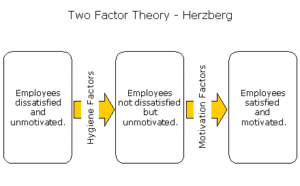 Most people, after reading the title of this post, may say “well…of course they do.” However, given the fact that so many American workers are unsatisfied with their work, it’s a wonder why so many organizational decision-makers focus on either monetary or punishment tactics to motivate their workforce. All the while, these same decision-makers fail to consider the impact of their organization’s culture on employee productivity.
Most people, after reading the title of this post, may say “well…of course they do.” However, given the fact that so many American workers are unsatisfied with their work, it’s a wonder why so many organizational decision-makers focus on either monetary or punishment tactics to motivate their workforce. All the while, these same decision-makers fail to consider the impact of their organization’s culture on employee productivity.
First, let me start off by saying the following very important thing: (a) organizational culture is entirely communicative and (b) organizational culture is regularly changing (there are multiple sources to support those two assertions). Therefore, with those two things in mind, the culture of an organization can be changed with the implementation of proper communicative elements among the members of the organization. In this sense, one way to improve an organization is to improve the way that social support is communicated (see my dissertation for a very long and boring explanation on this topic).
I was excited when I saw the a post at UPI.com, which reported the findings of a research study on this very topic. Here is the article in its entirety (note that this is a direct quote):
“ROTTERDAM, Netherlands, July 23 (UPI) — It pays for employers to provide social support, feedback and employee opportunities for autonomy, variety and growth, Dutch researchers say. Arnold B. Bakker, a psychologist at Erasmus University Rotterdam in the Netherlands, say when employees satisfy basic human needs for social support, feedback and employee opportunities for growth, work gets done more quickly and with better results. The process is cyclical, because working better is more rewarding for the worker, which in turn increases the employee’s engagement and effectiveness, Bakker says. Interestingly, engagement — or high-quality performance — is greatest when the demands of the job are highest, Bakker adds. No worker should expect to feel, or be expected to exhibit, peak engagement every second of the workday — work can also sometimes be tedious and employees need to be able to tolerate that. However, workers should not be held to impossible standards. “Down time,” says Bakker, “is not only a mark of sympathetic management. It helps renew workers, keeping them happy, productive and engaged,” which in turn results in a virtuous cycle of work engagement, job satisfaction and higher productivity. The findings are scheduled to be published in the August issue of Current Directions in Psychological Science.”
So, of course I am excited to read the article once it comes out in the journal, but in the meantime, I have a few ideas as to what the researchers are claiming to have found. First, the idea that social support leads to greater productivity isn’t necessarily a new finding. In fact, theorists going back to Abraham Maslow in the early 1940s who explored the idea that individuals must meet certain “basic” needs before attempting to satisfy certain “higher-order” needs. Yes, there are a variety of (valid) critiques of his theory, but the basic idea of the theory is rather applicable to workers. In the workplace, individuals must first feel safe before they can develop deeper relationships with their coworkers (see the work of Elton Mayo for more information here).
Flash forward to 1968 — Frederick Herzberg publishes a groundbreaking article in Harvard Business Review. In this article, he proposes a theory (called Motivation-Hygiene or Two-Factor Theory) as an attempt to demonstrate to organizational decision makers that there are a variety of ways to motivate employees to do their job. The basic premise of his theory is that both environmental factors (hygiene) and psychological factors (motivation) must be present for an employee to reach his or her full potential. The theory isn’t too complicated — a combination of specific changes to actual working conditions combined with some factors to make employees feel valued can be the impetus to improve productivity. Here is an example:
 So, both the motivation and hygiene factors are simple to add to a workplace. You will see some of the main motivation factors are intrinsic to workers — make people feel respected, recognized, and able to grow. While the hygiene factors are what makes the working location pleasant — good coworkers, quality supervision, and decent pay. Putting the theory together, looks something like this:
So, both the motivation and hygiene factors are simple to add to a workplace. You will see some of the main motivation factors are intrinsic to workers — make people feel respected, recognized, and able to grow. While the hygiene factors are what makes the working location pleasant — good coworkers, quality supervision, and decent pay. Putting the theory together, looks something like this:
 So, those places that do not have either hygiene or motivation factors have employees who are dissatisfied and unmotivated. Only until both elements are present do we have employees who are both satisfied and motivated. Simple, right? Absolutely…some say too simple.
So, those places that do not have either hygiene or motivation factors have employees who are dissatisfied and unmotivated. Only until both elements are present do we have employees who are both satisfied and motivated. Simple, right? Absolutely…some say too simple.
To those people, I tend to agree with you. There is something underlying all of these theories and especially this research study — a focus on productivity. Okay, now that I am bringing this point up, I am sure someone will say to me “well, if not productivity, then what?” I don’t necessarily have a direct response to that. Instead, what I have to say is that productivity is a variable important to business owners and executives and less important to employees. Why is that?
While there are a variety of answers to this question, I think that one of the important elements is that humans work in organizations in order to build social relationships and create something greater than themselves. So, when the only output of an organization is measured in productivity, little attention is given to the intrinsic motivation keeping people working — social connectivity. Sure, people do work to support themselves, for money and resources, etc.
We spend so many of our daily hours in organizations. The mentality for most is that the place is just where we go to make money. Perhaps when organizations start to focus on the larger and more important issues, such as developing a place where people feel that they are part of a community, they can focus less on those measurable outputs and more on the thing that makes us all human. I think that once organizations do that, productivity will develop naturally in those organizations. There are already some excellent examples of such working environments, that I know it’s possible. Think of it this way — people start their job for the paycheck, stay for the people, and work harder because they believe in what they are doing. Perhaps more organizations need to remember that. That’s support @ work.
